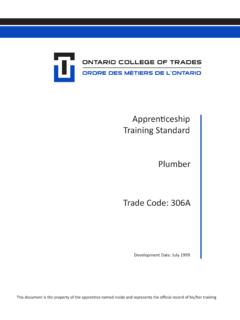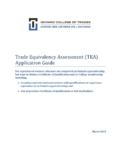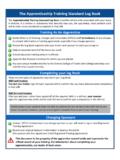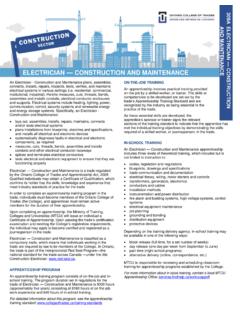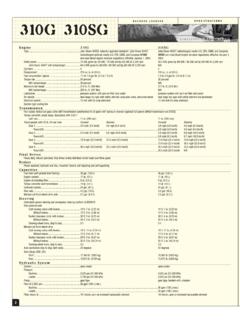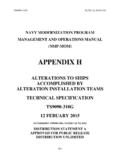Transcription of Apprenticeship Curriculum Standard Level 1 Trade …
1 Apprenticeship Curriculum Standard motorcycle technician Level 1. Trade Code: 310g . Date: 2007. Please Note: Apprenticeship Training and Curriculum Standards were developed by the Ministry of Training, Colleges and Universities (MTCU). As of April 8th, 2013, the Ontario College of Trades (College) has become responsible for the development and maintenance of these standards. The College is carrying over existing standards without any changes. However, because the Apprenticeship Training and Curriculum Standards documents were developed under either the Trades Qualification and Apprenticeship Act (TQAA) or the Apprenticeship and Certification Act, 1998 (ACA), the definitions contained in these documents may no longer be accurate and may not be reflective of the Ontario College of Trades and Apprenticeship Act, 2009 (OCTAA) as the new trades legislation in the province.
2 The College will update these definitions in the future. Meanwhile, please refer to the College's website ( ) for the most accurate and up-to-date information about the College. For information on OCTAA and its regulations, please visit: Ontario College of Trades . motorcycle technician Level 1. TABLE OF CONTENTS. Introduction .. 2. Program Summary of Reportable Subjects .. 3. S0146 Engines .. 4. - Engines .. 5. - Engine Lubrication systems .. 13. S0147 Power Trains .. 16. - Primary Drive 17. - 20. - Manual Transmissions .. 24. S0148 Braking Systems and Chassis .. 27. - Braking Systems .. 28. - 33. S0149 Electrical/Electronic and Fuel Systems .. 38. - Electrical/Electronic System 39. - Lead Acid Batteries .. 43. - Applied Electrical Schematics .. 46. - Fuel 48. S0150 Work 53.
3 - Workshop Practices and 54. - Fastening & Sealing Techniques .. 58. - 61. Ontario College of Trades . motorcycle technician Level 1. Introduction This new Curriculum Standard for the motorcycle technician Trade is designed from the learning outcomes, which were developed from the industry-approved training Standard . The Curriculum is organized into 2 levels of training, each including reportable subjects containing learning outcomes to reflect the units of the training Standard . The hours charts indicate how the Curriculum can be delivered in the current block release format and summarizes the hours of training for each reportable by Level . Since the reportable subjects are all divisible by three they can be adapted to accommodate a more flexible training delivery other than block release.
4 The reportable subjects are cross-referenced to the training Standard for ease of comparison. Each reportable subject and learning outcome identifies a recommended number of training hours. This hour allotment is broken into hours for instruction in theory and practical application. The division of the Curriculum into reportable subjects follows a natural progression of learning through the training program. This structure will allow training centres and apprentices' flexibility in program delivery while still observing the importance of sequencing learning in a logical progression. The Curriculum is framed by and includes specific references to terminal performance objectives in the Apprenticeship Training Standards. However, the Curriculum identifies only the learning that takes place off the job, in a training environment.
5 The in-school program focuses primarily on the theoretical knowledge required to master the performance objectives of the Training Standards. Employers are expected to extend the apprentice's knowledge and skills through appropriate practical training on the work site. Regular evaluations of the apprentice's knowledge and skills are conducted throughout training to assure that all apprentices have achieved the learning outcomes identified in the Curriculum Standard . The balance between theoretical and practical evaluation is identified for each unit of learning outcomes. Implementation date: September, 2007. 2. Ontario College of Trades . motorcycle technician Level 1. Program Summary of Reportable Subjects Hours Hours Hours Number Reportable Subjects Total Theory Practical S0146 Engines 62 45 17.
6 S0147 Power Trains 36 22 14. S0148 Brakes and Chassis 40 20 20. S0149 Electrical/Electronic and Fuel Systems 62 40 22. S0150 Work Practices 40 24 16. Total 240 151 89. 3. Ontario College of Trades . motorcycle technician Level 1. Number: S0146. Title: Engines Duration: 62 Total Hours Theory: 45 hours Practical: 17 hours Prerequisites: None Co-requisites: Level 1 Reportable Subject S0147, S0148, S0149, S0150. Evaluation & Testing: - Assignments related to theory and appropriate application skills. - Minimum of one mid-term test during the eight-week term. - Final exam at end of term. - Periodic quizzes. General Learning Outcome Upon successful completion of this reportable subject, the apprentice is able to service and repair engines in accordance with government safety regulations, manufacturer's recommendations and specifications and approved industry standards.
7 4. Ontario College of Trades . motorcycle technician Level 1. Number: Title: Engines Duration: 58 Total Hours Theory: 42 hours Practical: 16 hours Prerequisites: None Co-requisites: Level 1 Reportable Subject S0147, S0148, S0149, S0150. Cross-Reference to Training Standards: to ; to ; to ; to GENERAL LEARNING OUTCOME. Demonstrate a working knowledge of the definitions and applied fundamentals of 2 and 4. stroke cycle motorcycle internal combustion engines. LEARNING OUTCOMES. Upon successful completion, the apprentice is able to: Outline the history, purpose, function, type, styles and application of motorcycle engines. Describe the basic principles of operation of motorcycle engines. Describe the construction and principles of operation of 4 stroke cycle engines. Describe the construction and principles of operation of a 2 stroke cycle motorcycle engine.
8 Demonstrate a theoretical understanding of motorcycle 2 and 4 stroke cycle top end repair practices. Perform assigned 2 and 4 Stroke Cycle top end repair practices. Perform assigned operations on motorcycle 2 and 4-stroke cycletop end assemblies. Describe manufacturer's test and maintenance procedures for 2 and 4 stroke cycle motorcycle top end disassembly / reassembly procedures. 5. Ontario College of Trades . motorcycle technician Level 1. Learning Content Explain the history, purpose, function, type, styles and application of motorcycle engines. [4/0]. fundamentals: - bore - stroke - engine displacement - brake power - compression ratio - pressure-efficiency ratios - thermal efficiency - mechanical efficiency - gas expansion - mechanical advantage - inertia - engine breathing - gas inertia - balance shifts Describe the basic principles of operation of motorcycle engines.
9 [4/0]. power transfer - piston - connecting rod - crankshaft - primary drive fixed engine components - cylinder head - squish band - cylinder - crank case - engine covers induction and exhaust principles - engine breathing Describe the construction and principles of operation of 4 stroke cycle engines. [6/2]. 4-stroke cycle sequencing - intake - power 6. Ontario College of Trades . motorcycle technician Level 1. - valve timing - compression - exhaust valve arrangements - side valve - overhead valve - pushrod - overhead cam valve configurations - single - multiple valve operating mechanisms - camshaft - rocker arms/lifters/pushrods - camshaft drive - roller chain/sprockets - inverted tooth chain/sprockets - toothed belt/pulley - gear - valve lash factors - hydraulic - adjuster screw/locknut - eccentric - shim - decompression mechanisms combustion chambers - hemispherical - multispherical - bath tub - wedge pistons - forged - cast - silicon content - piston section - coatings - crown design - cam ground - taper - pin offset 7.
10 Ontario College of Trades . motorcycle technician Level 1. - pin support area - cir-clip groove ring design - compression rings types - oil control types - sealing - scraper cylinder wall materials - cast iron - sleeve - aluminum - coatings crankshafts - one piece/assembled Describe the construction and principles of operation of a 2 stroke cycle motorcycle engine. [6/2]. 2 stroke cycle event sequencing - intake - primary compression - transfer - secondary compression - combustion/power - exhaust induction system - piston port - inspection - measurement - out of service - timing out of service reed - cylinder - crankcase - materials rotary - timing symmetrical/asymmetrical - sequencing crankshaft - assembled decompression mechanisms 8. Ontario College of Trades . motorcycle technician Level 1.



